Related Research Articles

The Bureau of Engraving and Printing (BEP) is a government agency within the United States Department of the Treasury that designs and produces a variety of security products for the United States government, most notable of which is Federal Reserve Notes for the Federal Reserve, the nation's central bank. In addition to paper currency, the BEP produces Treasury securities; military commissions and award certificates; invitations and admission cards; and many different types of identification cards, forms, and other special security documents for a variety of government agencies. The BEP does not produce coins; all coinage is produced by the United States Mint. With production facilities in Washington, D.C., and Fort Worth, Texas, the Bureau of Engraving and Printing is the largest producer of government security documents in the United States.

A rubber stamp is an image or pattern that has been carved, molded, laser engraved or vulcanized onto a sheet of rubber. Rubber stamping, also called stamping, is a craft in which some type of ink made of dye or pigment is applied to rubber stamp. The rubber is often mounted onto a more stable object such as a wood, brick or an acrylic block. Increasingly the vulcanized rubber image with an adhesive foam backing is attached to a cling vinyl sheet which allows it to be used with an acrylic handle for support. These cling rubber stamps can be stored in a smaller amount of space and typically cost less than the wood mounted versions. They can also be positioned with a greater amount of accuracy due to the stamper's ability to see through the handle being used. Temporary stamps with simple designs can be carved from a potato. The ink-coated rubber stamp is pressed onto any type of medium such that the colored image is transferred to the medium. The medium is generally some type of fabric or paper. Other media used are wood, metal, glass, plastic, and rock. High-volume batik uses liquid wax instead of ink on a metal stamp.
Messrs. Perkins, Bacon & Co was a printer of books, bank notes and postage stamps, most notable for printing the Penny Black, the world's first adhesive postage stamps, in 1840.

Embossing and debossing are the processes of creating either raised or recessed relief images and designs in paper and other materials. An embossed pattern is raised against the background, while a debossed pattern is sunken into the surface of the material but might protrude somewhat on the reverse side.

The adhesive embossed postage stamps of the United Kingdom, issued during the reign of Queen Victoria between 1847 and 1854 exhibit four features which are unique to this issue:

The Penny Blue is frequently mistaken for a postage stamp of Britain. It is from a series of proof impressions which were made at the time Rowland Hill was looking at the new colours which were to be used for the stamps which were to replace the Penny Black and the original 1840 issue of the Two pence Blue.
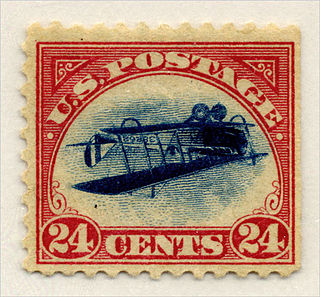
In philately, errors, freaks, and oddities (EFO) collectively refers to the wide variety of mistakes that can happen in the production of postage stamps. It encompasses everything from major design errors to stamps that are just poorly printed and includes both some of the most sought-after and expensive of all stamps and others that attract the attention of only a few specialists.
Franking comprises all devices, markings, or combinations thereof ("franks") applied to mails of any class which qualifies them to be postally serviced. Types of franks include uncanceled and precanceled postage stamps, impressions applied via postage meter, official use "Penalty" franks, Business Reply Mail (BRM), and other permit Imprints (Indicia), manuscript and facsimile "franking privilege" signatures, "soldier's mail" markings, and any other forms authorized by the 192 postal administrations that are members of the Universal Postal Union.

The postage and revenue stamps of the United Kingdom issued in 1887 are known as the "Jubilee" issue because they were issued during the year of the Golden Jubilee of the accession of Queen Victoria to the throne in 1837. They continued in use throughout the remainder of Victoria's reign, and many of the designs were reused in the stamps of Edward VII. The Jubilee issue includes the first British stamps to be printed in two colours.

In philately, indicia are markings on a mail piece showing that postage has been prepaid by the sender. Indicia is the plural of the Latin word indicium, meaning distinguishing marks, signs or identifying marks. The term imprinted stamp is used more or less interchangeably, but some indicia are not imprinted stamps. One example is the handstamp, which can be seen in a photo on this page.
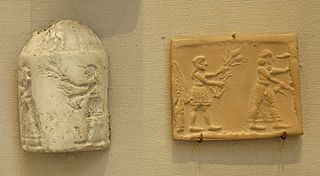
A cylinder seal is a small round cylinder, typically about one inch in length, engraved with written characters or figurative scenes or both, used in ancient times to roll an impression onto a two-dimensional surface, generally wet clay. According to some sources, cylinder seals were invented around 3500 BC in the Near East, at the contemporary sites of Uruk in southern Mesopotamia and slightly later at Susa in south-western Iran during the Proto-Elamite period, and they follow the development of stamp seals in the Halaf culture or slightly earlier. They are linked to the invention of the latter's cuneiform writing on clay tablets. Other sources, however, date the earliest cylinder seals to a much earlier time, to the Late Neolithic period, hundreds of years before the invention of writing.

The Bluenose is the nickname for a 50-cent definitive postage stamp issued by the Canadian Post Office on 8 January 1929 as part of the King George V "Scroll Issue". Scott number is 158 with a perforation of 12. The stamp depicts the fishing schooner Bluenose and the design, by the Canadian Bank Note Company, Ottawa, is a montage of two different images of the vessel, racing off Halifax Harbour. The stamp is considered a classic even though it was issued after 1900. It has been called "Canada's Finest Stamp" and is a favorite among collectors.
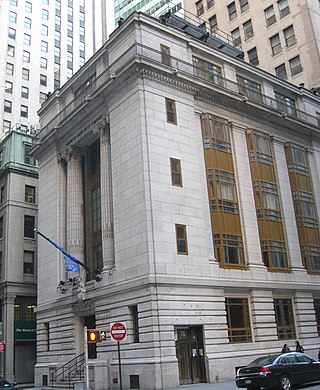
ABCorp is an American corporation providing contract manufacturing and related services to the authentication, payment and secure access business sectors. Its history dates back to 1795 as a secure engraver and printer, and assisting the newly formed First Bank of the United States to design and produce more counterfeit resistant currency. The company has facilities in the United States, Canada, Australia, and New Zealand. The American Bank Note Company is a wholly owned subsidiary of ABCorp.
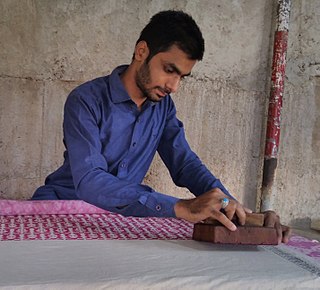
Woodblock printing on textiles is the process of printing patterns on textiles, usually of linen, cotton or silk, by means of incised wooden blocks. It is the earliest and slowest of all methods of textile printing. Block printing by hand is a slow process. It is however, capable of yielding highly artistic results, some of which are unobtainable by any other method.

A meter stamp, or meter mark, is the impression made by a postage meter machine that indicates that postage has been paid on a letter or parcel. Meter stamps are widely used by businesses and organisations as they are more efficient than using postage stamps.

Anatoli Nenartovich was a Soviet Russian painter, who lived and worked in Leningrad and known as representative of the Leningrad school of painting, most famous for his cityscapes with a road building works scenes.
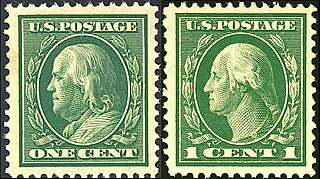
The Washington–Franklin Issues are a series of definitive U.S. Postage stamps depicting George Washington and Benjamin Franklin, issued by the U.S. Post Office between 1908 and 1922. The distinctive feature of this issue is that it employs only two engraved heads set in ovals—Washington and Franklin in full profile—and replicates one or another of these portraits on every stamp denomination in the series. This is a significant departure from previous definitive issues, which had featured pantheons of famous Americans, with each portrait-image confined to a single denomination. At the same time, this break with the recent past represented a return to origins. Washington and Franklin, after all, had appeared on the first two American stamps, issued in 1847, and during the next fifteen years, each of the eight stamp denominations available featured either Washington or Franklin.

Malaya Sadovaya Street is a 1979 oil painting by the Russian artist Alexander Semionov, depicting Malaya Sadovaya Street in Leningrad on rainy day of the end of the 1970s. This cityscape was painted in traditions of the Leningrad School of Painting and Soviet figurative painting of late socialist realism with their typical synthesis of realistic and impressionistic traditions to create an image of modernity.
The Australian State of Tasmania issued adhesive revenue stamps from 1863 to 1998, although impressed stamps had appeared briefly in the 1820s. There were general revenue and stamp duty issues, as well as a number of specific issues for various taxes.
Richard Harding was a British forger. He was capitally indicted and convicted of the forgery of brass duty legal stamps placed on the Ace of Spades and the selling and uttering of playing cards with the same, while knowing such duty stamp to be false. He was hanged at the Old Bailey, London, England in 1805.
References
- ↑ "Colas :: Architectural :: StreetPrint :: StreetPrint". Archived from the original on 2008-05-09. Retrieved 2011-12-09.